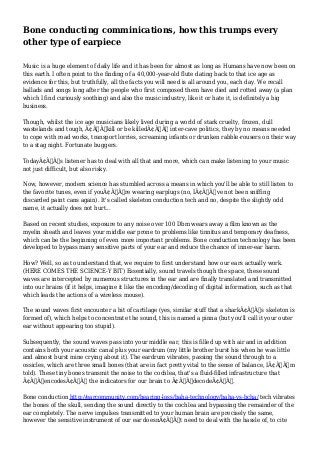
Bone conducting comminications, how this trumps every other type of earpiece
- 1. Bone conducting comminications, how this trumps every other type of earpiece Music is a huge element of daily life and it has been for almost as long as Humans have now been on this earth. I often point to the finding of a 40,000-year-old flute dating back to that ice age as evidence for this, but truthfully, all the facts you will need is all around you, each day. We recall ballads and songs long after the people who first composed them have died and rotted away (a plan which I find curiously soothing) and also the music industry, like it or hate it, is definitely a big business. Though, whilst the ice age musicians likely lived during a world of stark cruelty, frozen, dull wastelands and tough, ‘kill or be killed’ inter-cave politics, they by no means needed to cope with road works, transport lorries, screaming infants or drunken rabble-rousers on their way to a stag night. Fortunate buggers. Today’s listener has to deal with all that and more, which can make listening to your music not just difficult, but also risky. Now, however, modern science has stumbled across a means in which you'll be able to still listen to the favorite tunes, even if you’re wearing earplugs (no, I’ve not been sniffing discarded paint cans again). It's called skeleton conduction tech and no, despite the slightly odd name, it actually does not hurt... Based on recent studies, exposure to any noise over 100 Dbm wears away a film known as the myelin sheath and leaves your middle ear prone to problems like tinnitus and temporary deafness, which can be the beginning of even more important problems. Bone conduction technology has been developed to bypass many sensitive parts of your ear and reduce the chance of inner-ear harm. How? Well, so as to understand that, we require to first understand how our ears actually work. (HERE COMES THE SCIENCE-Y BIT) Essentially, sound travels though the space, these sound waves are intercepted by numerous structures in the ear and are finally translated and transmitted into our brains (if it helps, imagine it like the encoding/decoding of digital information, such as that which leads the actions of a wireless mouse). The sound waves first encounter a bit of cartilage (yes, similar stuff that a shark’s skeleton is formed of), which helps to concentrate the sound, this is named a pinna (but you'll call it your outer ear without appearing too stupid). Subsequently, the sound waves pass into your middle ear, this is filled up with air and in addition contains both your acoustic canal plus your eardrum (my little brother burst his when he was little and almost burst mine crying about it). The eardrum vibrates, passing the sound through to a ossicles, which are three small bones (that are in fact pretty vital to the sense of balance, I’m told). These tiny bones transmit the noise to the cochlea, that's a fluid-filled infrastructure that ‘encodes’ the indicators for our brain to ‘decode’. Bone conduction http://earcommunity.com/hearing-loss/baha-technology/baha-vs-bcha/ tech vibrates the bones of the skull, sending the sound directly to the cochlea and bypassing the remainder of the ear completely. The nerve impulses transmitted to your human brain are precisely the same, however the sensitive instrument of our ear doesn’t need to deal with the hassle of, to cite
- 2. Anchorman’s Brick Tamland “LOUD NOISES!†This method appears to be completely safe; in reality, the notably deaf composer Beethoven applied a rudimentary version of this process to be able to compose his most well-known works. He attached a rod linking his piano and his head and, as such, was able to hear the music he was playing. So here you go, instead of exposing your delicate ears to louder and louder volumes, to drown out the background noise, it is possible to alternativily stick your earpugs in and play your music at the correct volume. Make no bones about it (groan!) Original Source